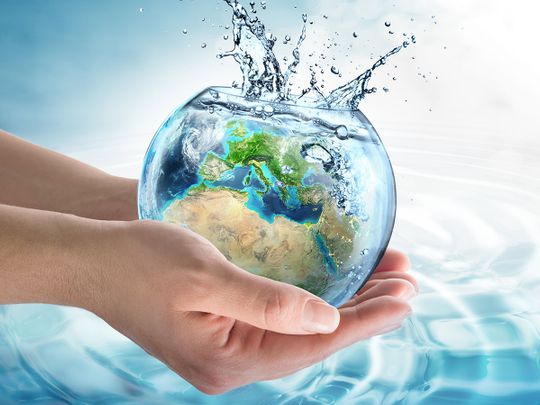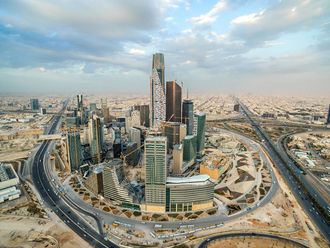
Water isn’t just the lifeblood of our planet but a facilitator of trade, bearer of nourishment, and for the longest period in human history, a natural body between cultures and civilisations.
Despite its natural abundance, access to potable water remains an increasing challenge due to environmental factors. The uneven distribution of freshwater as a renewable resource has meant over two billion people remain in water-stressed countries or only have access to contaminated sources.
In the wake of Dubai hosting the Arab Water Convention and ahead of the UAE hosting COP28 later in the year, I discuss the evolution and function of water and some of the global challenges we face.
Long before the discovery of microorganisms and the difference between sources, water was revered in many cultures ranging from Hinduism, which regards it as sacred; Buddhism, which embodies its calmness and serenity; Christianity in symbolising rebirth and purity; Islam, where water symbolises wisdom in the Holy Quran and Judaism where the mikveh, a traditional bath restores purity.
Water’s ‘universal’ attribute
Beyond this, water has a much deeper importance to nature and our physical wellness, with an increasing number of individuals and organisations beginning to commit further research to the hidden consciousness of water and the scientific link between brain function and water as a highly effective neurotransmitter.
At its structural level, water is a simple molecule of two smaller positively charged hydrogen atoms and one larger, negatively charged oxygen atom, which upon binding, create a polarity. As a result, water molecules can form strong bonds with other polar molecules, including its own, which provides cohesion, allowing it to break up other substances, earning it the title of a ‘universal solvent’.
At a biological level, this enables water to play a crucial role in helping cells transport oxygen and nutrients around the body, plants to absorb it through their roots, and cells to maintain their shape through an even distribution of pressure.
Healthcare professionals typically recommend that most people drink between 8-12 cups of water daily to remain hydrated and even more when including factors such as exercise, hot weather, high altitude, high fibre diet or after consuming stimulants such as caffeine. While less common, too much water can also have an adverse effect, although this is typically the result of drinking more than a litre per hour for several hours in a row, which can result in hyper-hydration, water toxaemia and or water poisoning.

Part of the cure
With water making up 60–75 per cent of the human body, it is no wonder that its consumption goes beyond staving off thirst and into a long list of physiological benefits, many of which have been empirically evident since the dawn of man.
According to M.N Baker and Michael Taras in their book, The Quest for Pure Water: The History of Water Purification from the Earliest Records to the Twentieth Century, the search for pure water may have started in the prehistoric era, with the earliest documentation of water treatment found in the ancient Sanskrit text of Sushruta Samhita.
Considered one of the most important medical records to survive the ancient world, and a foundational text of Ayurveda, it mentions purification methods, including boiling, heating under the sun, or filtering through sand, while later inscriptions on the walls of the tombs of Egyptian rulers including Amenophis II and Rameses II, display pictures of water clarifying apparatus.
By 4th century BC, the Greek physician Hippocrates had developed his eponymous ‘sleeve’, a cloth bag through which water could be poured after being boiled, trapping sediment and reducing undesired taste and smell. The Greek and Roman civilizations understood turbidity problems and the side effects of dissolved calcium and magnesium. This led to the Romans developing huge settling pools at the head of their aqueducts.
Filtration comes into being
At the same time, both the Greek and Egyptian dynasties utilized filtration through porous clay jars, a technique recreated by John Doulton using ceramic filters as a defence against Victorian England’s outbreaks of typhoid and cholera.
Indeed, the evolution of water filtration remained relatively stagnant for several hundred years, particularly during the Middle Ages, when fermented beverages such as mead and ale became popular substitutes for potentially lethal, contaminated water. It wasn’t until 1804 when the town of Paisley in Scotland introduced the world’s first municipal water purifying plant, utilising a system of gravel filters and concentric sand.
By the middle of the 19th century, and primarily thanks to the ground-breaking work conducted by Louis Pasteur, arguably the godfather of modern immunology, a greater understanding of microorganisms and their link to disease meant an even more rigorous approach towards the treatment of water, and ultimately the widespread use of potable water.
Such was the impact that within the first thirty years of the 20th century, life expectancy jumped between 10–15 years in countries where potable water had become generally accessible.
Defining water’s quality
Under European Community legislation, drinking water has been bureaucratically redefined for health and safety purposes, while mineral waters require more stringent measures, including the number of residual mineral salts (in mg), pH balance, temperature, and hardness. Classified by the fixed residue at 180-degree Celsius, or the number of residual mineral salts in milligrams after the evaporation of one litre of water, mineral status’ range from low to high with additional parameters including temperature at source, and the presence of alkaline earth metals.
Regarding health properties, water connoisseurs typically consider both macro and micro-nutrients, ranging from calcium, which supports bone development, blood clotting and the regulation of cell permeability, to cobalt, a constituent of vitamin B12.
As a net outcome, mineral water has been shown to contribute towards heart health by lowering the levels of bad (LDL) cholesterol and raising the levels of good (HDL) cholesterol while reducing blood pressure and relieving the symptoms of constipation. Consequently, the search has been on for many years to find the ultimate source of the ‘world’s healthiest water’, with several destinations claiming the title, including Puerto Williams in the Patagonian region of Chile, through to the Ontario townships of Tiny and Tay in Canada.
In general terms, Switzerland, Iceland, and the Scandinavian countries are reputed to have the highest quality tap water, although quality, it seems, is subjective to its purpose.
Coming up with the best cuppa
In the artisan world of tea-making, distilled water is typically viewed as the best choice, while activated carbon filtered water is favoured in coffee making as it aids in the removal of odours, impurities, limescale and chlorine. Generally, water with higher magnesium concentrations enhances the flavour, while calcium adds bitterness, depending on preference.
When adding the seemingly innate knowledge of our ancestors with our clear leaps in scientific and technical expertise, it is hard to imagine why water purity and scarcity is a prevalent issue. And while a topic that requires a lot more investigation, it would appear the high-level causes are governmental/ corporate carelessness or recklessness, agricultural proliferation, and micro-pollutants.
In the first circumstance, cases such as Flint, Michigan, where the community’s water supply was diverted from the Detroit system to the Flint River to cut costs, aren’t isolated. Unfortunately, inadequate treatment and testing caused significant health issues for residents, including skin rashes, hair loss and itchy skin.
As it transpired, the Flint River had been used as an unofficial waste disposal site for treated and untreated refuse from many local industries, ranging from car factories to meatpacking plants, not to mention raw sewage from the city’s waste treatment plant, agricultural and urban runoff, and toxins from leaching landfills.

A case against contamination
Other cases of severe water pollution include the Woburn, Massachusetts contamination, which was linked to childhood leukaemia, liver, kidney, prostate, and urinary cancer, as well as congenital abnormalities across the local community. In other large population centres, such as those near India’s highly polluted Yamuna River, illnesses and deaths related to toxicity and disease are well documented.
Where agriculture is concerned, it is the biggest consumer of freshwater resources, responsible for approximately 70 per cent of all consumption, while simultaneously a massive polluter, with the sector recognised as the leading cause of water degradation, as well as a significant contributor towards the contamination of estuaries and groundwater due to fertilizers, pesticides, and animal waste. Other mass-consuming industries, while more recent, include the nascent emergence of data centres, with a recent report stating that Google’s data centre usage ranks in the billions of gallons per year.
Arguably the most challenging issue comes in the form of micro-pollutants. These include hormones and endocrine disruptors, particularly oestrogen from the widespread use of the female contraceptive pill, and BPA (bisphenol A), a chemical used in the production of plastics which imitates the effects of oestrogen.
Unfortunately, these micro-pollutants have been shown to severely disrupt hormone levels, causing increased risks of food intolerance, infertility, congenital disabilities, obesity, and cardiovascular diseases.
The good news is there is enough water for everyone – the bad news is that our approach towards usage, treatment and distribution needs to change, which is why I am advocating for the promotion of knowledge.
I will talk about improvements in water consumption, sourcing, the innovations being made, and how businesses and governments can take a more responsible approach towards treating our most valuable resource.













